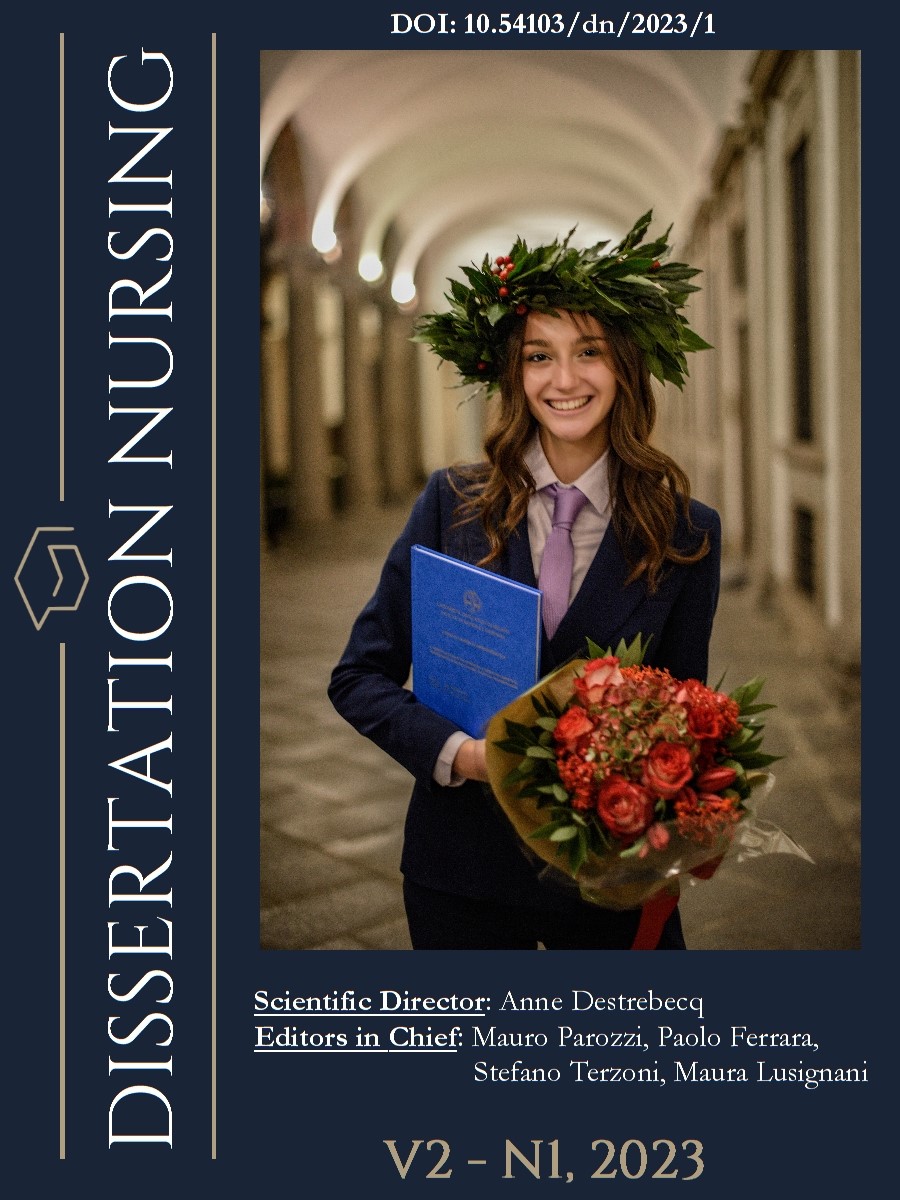The new color code for priority assessment in nursing triage: a pilot study
DOI:
https://doi.org/10.54103/dn/19427Keywords:
Triage, Nurses, nurse, assessment, emergencyAbstract
BACKGROUND:
Since the volume of patient admissions in an emergency department (ED) cannot be planned precisely, the available resources can sometimes be overloaded ('crowding'), resulting in risks to patient safety.
AIM:
The study aimed to evaluate the effectiveness of a new triage evaluation system in the emergency room of an Italian hospital.
METHODS:
Two-arm pilot study; assignment to the two groups (standard assessment - 4-colour code vs. experimental assessment - 5-colour code) by simple randomisation. Nursing assessments at admission triage were compared with those at discharge
RESULTS:
1060 subjects with 'non-traumatic chest pain' and 960 classified as 'acute neurological disorders' were enrolled; the implementation of the new color code allowed a correct assessment of the level of severity in more than 86% of 'cardiological' and 93% of 'neurological' cases; the standard method allowed a correct assessment of less than 83% in cardiological and 77% in neurological cases.
CONCLUSIONS:
The five-level triage system is a valid method for assessing the severity of incoming patients' conditions by nursing staff in the emergency department. In-depth studies on broader samples are recommended.
References
Bossaert L, Perkins GD, Askitopoulou H, Raffay VI, Greif R, Haywood KL, et al. European Resuscitation Council Guidelines for Resuscitation 2015 Section 11. The ethics of resuscitation and end-of-life decisions. Resuscitation. 2015;95:302-11.
Shin SD, Ong ME, Tanaka H, Ma MHM, Nishiuchi T, Alsakaf O, et al. Comparison of emergency medical services systems across Pan-Asian countries: a Web-based survey. Prehospital Emerg Care. 2012;16:477-96.
Hock Ong ME, Shin SD, Sung SS, Tanaka H, Huei-Ming M, Song KJ, et al. Recommendations on ambulance cardiopulmonary resuscitation in basic life support systems. Prehospital Emerg Care. 2013;17:491-500.
Drennan IR, Lina S, Sidalak DE, Morrison LJ. Survival rates in out-ofhospital cardiac arrest patients transported without prehospital return of spontaneous circulation: An observational cohort study. Resuscitation. 2014;85:1488-93.
Zive D, Koprowicz K, Schmidt T, Stiell I, Sears G, Van Ottingham L, et al. Variation in out-of-hospital cardiac arrest resuscitation and transport practices in the Resuscitation Outcomes Consortium: ROC Epistry-Cardiac Arrest. Resuscitation. 2011;82:277-84.
Rosell Ortiz F, Mellado Vergel F, Fernández Valle P, González Lobato I, Martínez Lara M, Ruiz Montero MM, et al. Descripción y resultados iniciales del registro andaluz de parada cardiaca extrahospitalaria. Emergencias. 2013;25:345-52.
Perkins GD, Jacobs IG, Nadkarni VM, Berg RA, Bhanji F, Biarent D, et al, for the Utstein Collaborators. Cardiac arrest and cardiopulmonary resuscitation outcome reports: update of the Utstein Resuscitation Registry Templates for Out-of-Hospital Cardiac Arrest: a statement for healthcare professionals from a task force of the International Liaison Committee on Resuscitation (American Heart Association, European Resuscitation Council, Australian and New Zealand Council on Resuscitation, Heart and Stroke Foundation of Canada, InterAmerican Heart Foundation, Resuscitation Council of Southern Africa, Resuscitation Council of Asia); and the American Heart Association Emergency Cardiovascular Care Committee and the Council on Cardiopulmonary, Critical Care, Perioperative and Resuscitation. Resuscitation. 2015;11:328-40.
Cha W C, Lee E J, Hwang S. The duration of cardiopulmonary resuscitation in emergency departments after out-of-hospital cardiac arrest is associated with the outcome: A nationwide observational study. Resuscitation. 2015;96:323-7.
Ong ME, Mackey KE, Zhang ZC, Tanaka H, Ma MHM, Swor R, et al. Mechanical CPR devices compared tomanual CPR during out-of-hospital cardiac arrest and ambulance transport: asystematic review. Scand J Trauma Resusc Emerg Med. 2012;20:39.10.
Rosell-Ortiz F, Mellado-Vergel FJ, López-Messa JB, Fernández-Valle P, Ruiz-Montero MM, González-Lobato I, et al. Survival and neurological status after out-of-hospital cardiac arrest in the pediatric population in Andalusia. Med Intensiva. 2016;40:163-8.
Nehme Z, Andrew E, Bernard S, Smith K. Impact of cardiopulmonary resuscitation duration on survival from paramedic witnessed out-of-hospital cardiac arrests: An observational study. Resuscitation. 2016;100:25-31.
Stub D, Nehme Z, Bernard S, Lijovic M, Kaye DM, Smith K. Exploring which patients without return of spontaneous circulation following ventricular fibrillation out-of-hospital cardiac arrest should be transported to hospital? Resuscitation. 2014;85:326-31.
Fu-Yuan S, Chun-Chieh Ch, Chun-Wen Ch, Ying-Chen Ch, Yao-Li Ch, Yung-Kun H et al. Managing cardiac arrest with refractory ventricular fibrillation in the emergency department: Conventional cardiopulmonary resuscitation versus extracorporeal cardiopulmonary resuscitation Resuscitation. 2015;92:70-6.
Yannopoulos D, Bartos J A, Martin C, Raveendran G, Missov E, Conterato M, et al. Minnesota Resuscitation Consortium’s Advanced Perfusion and Reperfusion Cardiac Life Support Strategy for Out-of-Hospital Refractory Ventricular Fibrillation. J Am Heart Assoc. 2016;5:e003732.
Stub D, Bernard S, Pellegrino V, Smith K, Walker T, Sheldrake J, et al. Refractory cardiac arrest treated with mechanical CPR, hypothermia, ECMO and early reperfusion (the CHEER trial). Resuscitation. 2015;86:88-94.
Jabre P, Bougouin W, Dumas F, Carli P, Antoine C, Jacob L, et al. Early Identification of Patients With Out-of-Hospital Cardiac Arrest With No Chance of Survival and Consideration for Organ Donation. Ann Intern Med. 2016;165:770-8.
Rosell-Ortiz F, Escalada-Roig X, Fernández Del Valle P, Sánchez-Santos L, Navalpotro-Pascual JM, Echarri-Sucunza A, et al. Out-of-hospital cardiac arrest (OHCA) attended by mobile emergency teams with a physician on board. Results of the Spanish OHCA Registry (OSHCAR). Resuscitation. 2017;113:90-5.
Ministero della Salute. Linee Guida di indirizzo nazionali sul triage intraospedaliero, 2019 disponibile al sito: https://www.salute.gov.it/imgs/C_17_notizie_3849_listaFile_itemName_1_file.pdf
Downloads
Published
How to Cite
Issue
Section
License
Copyright (c) 2023 Carlo Alboreo, Dott.ssa Rossella Carneade, Annalisa Della Monica, Dott.ssa Tatiana Bolgeo, Angela Carpentiere, Lucia Di Nardo

This work is licensed under a Creative Commons Attribution-NonCommercial-NoDerivatives 4.0 International License.
Accepted 2023-01-02
Published 2023-01-30











